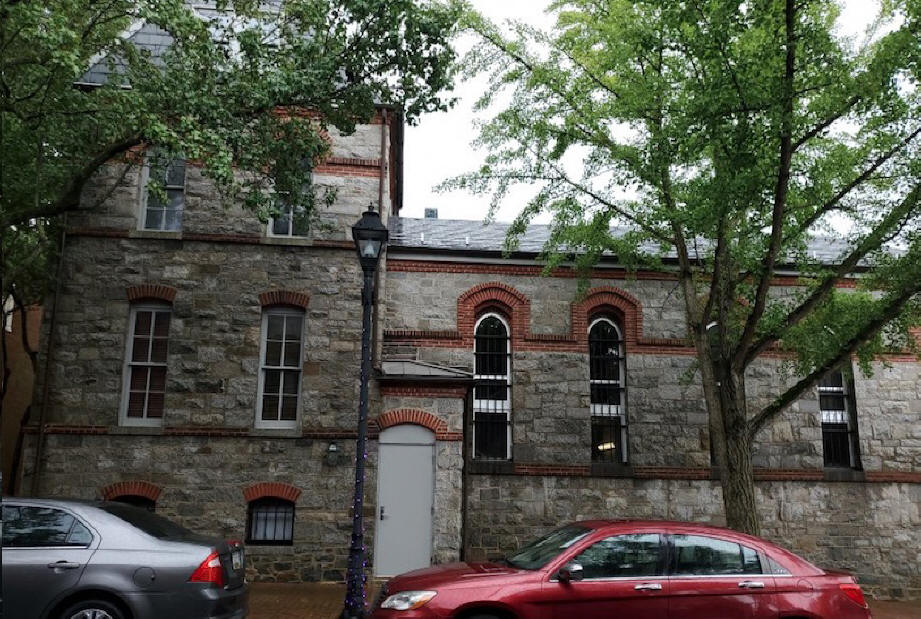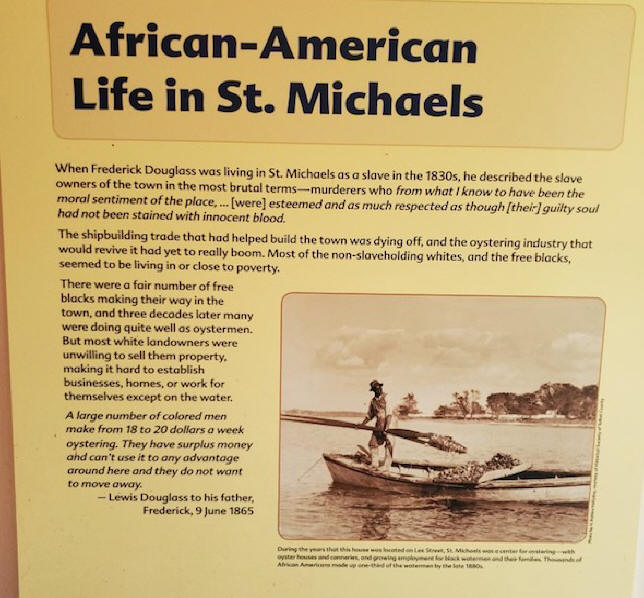
|
|
|
|
The Civil War left many black Union soldiers rootless after separation from the service. In 1866 Quakers Ezekiel and John Cowgill gave 18 ex-soldiers plots of land for $1.00 annually. The men and their families settled in Cowgilltown, later renamed Unionville, and many descendants remain there. Their original church, St. Stephens A.M.E., is still active and the eighteen founders and members of Douglass’ family are interred in the churchyard.
 In 1835 he became the field hand of William Freeland and on April 2, 1836 Douglass and several other slaves were jailed after another slave exposed a planned escape plot. They were walked 20-miles to be jailed in Easton. The jail is around the corner from the still active Talbot County Courthouse. The Frederick Douglass Statue on the courthouse lawn depicts him in 1878 as he delivered a speech in the main courtroom.    _ _ Easton dates from 1659 and is at the heart of Talbot County. A free black community, The Hill, was established circa 1788 and an 11-stop tour relates their experiences throughout the centuries. In 1878 Douglass addressed gatherings at both 1818 Bethel A.M.E. and 1836 Asbury United Methodist Churches. Bethel continues to use the rostrum from which Douglass spoke. The Tidewater Inn, 101 East Dover Street, was the site of the Hotel Avon when Douglass made his final visit to Talbot County in 1893. He stayed there during his visit. In 1944 the Avon burned down and three years later the Tidewater Inn was constructed. The Tidewater Inn offers luxury accommodations, Hunter’s Tavern, Terrasse Spa, free parking and WIFI. The staff is committed to the highest personal protective standards so that each guest can have peace of mind and enjoy their visit. Auld sent Douglass to Fell’s Point in Baltimore for the final time prior to his escape to freedom in 1836.  Through both triumph and tragedy Douglass never lost his affection for the Eastern Shore. You can trace his journey and better understand the man, his motivations and the sheer beauty of the Chesapeake Bay, North America’s largest estuary. #visitMaryland
Renee Gordon has written a weekly travel column for the Philadelphia Sun Newspaper for the past fifteen years and has published articles on local, national and international travel in numerous publications. Her columns focus on cultural, historic and heritage tourism and her areas of specialization are sites and attractions related to African American and African Diaspora history. Renee has been a guest radio commentator on various aspects of tourism and appeared in a documentary, "The Red Summer of 1919". As an educator for thirty years she was an English teacher, event and meeting planner, served as an educational consultant and intern-teacher mentor. She contributed to textbooks on women's history and classroom management and has facilitated workshops on both subjects. Renee considers herself a "missionary journalist" and as such she continues to promote heritage and sustainable tourism. 2013 Recipient of African Diaspora World Tourism Flame Keeper in Media Award for Travel Writing Affiliations
We'd love your comments!
|
Connect with us on:
American Roads and | ||||||
|
Public Disclosure--
Please Read The FTC has a law requiring web sites to let their readers know if any of the stories are "sponsored" or compensated. We also are to let readers know if any of our links are ads. Most are not. They are just a way to direct you to more information about the article where the link is placed. We also have several ads on our pages. They are clearly marked as ads. I think readers are smart enough to know an ad when they see one but to obey the letter of the law, I am putting this statement here to make sure everyone understands. American Roads and Global Highways may contain affiliate links or ads. Further, as their bios show, most of the feature writers are professional travel writers. As such we are frequently invited on press trips, also called fam trips. On these trips most of our lodging, dining, admissions fees and often plane fare are covered by the city or firm hosting the trip. It is an opportunity to visit places we might not otherwise be able to visit. However, no one tells us what to write about those places. All opinions are 100% those of the author of that feature column. |
|||||||
|
Privacy Policy/ Archives /
Contributors /
Subscribe to
American Roads Books by
Kathleen Walls /
Contact /
Sponsor or Advertise/ American Roads & Global Highways Home Page
|


















